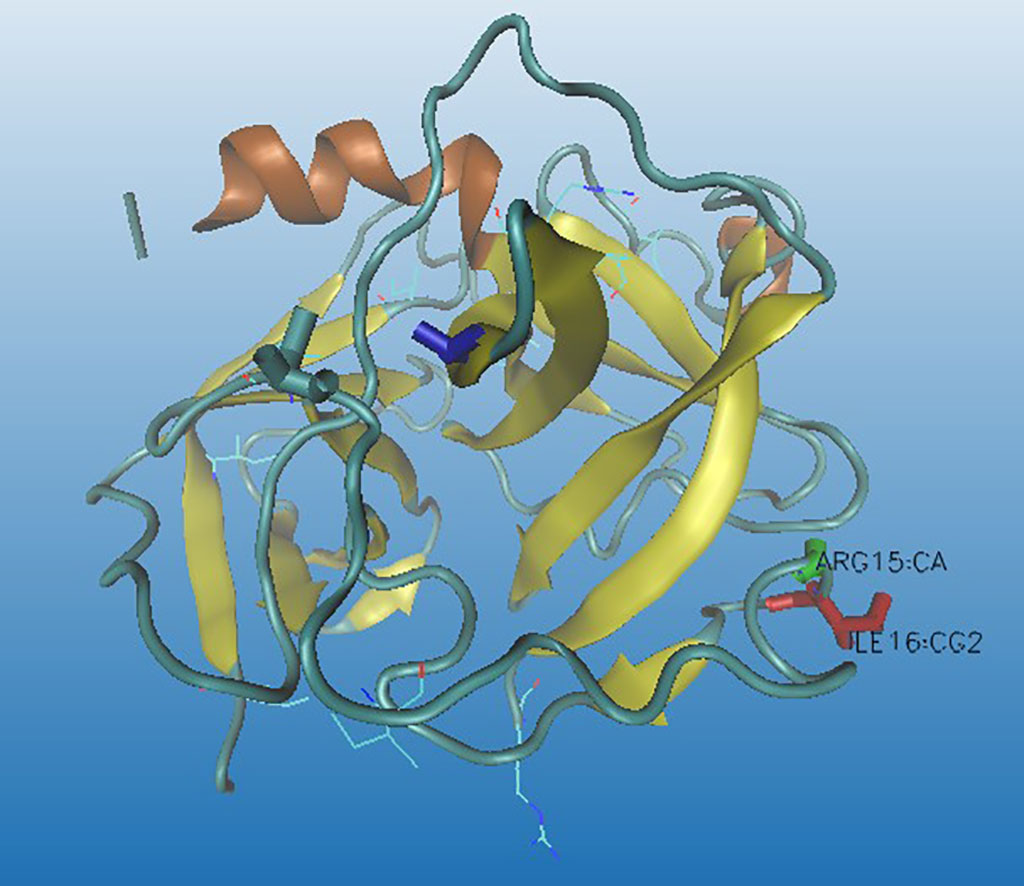Novel Protein Biomarkers Linked to Risk of Developing Type I Diabetes
|
By LabMedica International staff writers Posted on 22 Nov 2021 |

Image: Molecular model of chymotrypsinogen. Increased levels of chymotrypsinogen B1 (CTRB1) were associated with decreased risk of type I diabetes (Photo courtesy of Wikimedia Commons)
A recent study identified three novel circulating proteins associated with type I diabetes risk and that could potentially serve as diagnostic biomarkers for the disease.
Type I diabetes is an autoimmune disease that developes when very little or no insulin is produced by the islets of Langerhans (containing beta cells) in the pancreas. This type affects about 10% of people living with diabetes, but few biomarkers have been found that are able to predict the risk of developing the disease.
To rectify this situation, investigators at the University of Montreal (Canada) conducted a large-scale two-sample Mendelian randomization (MR) study of up to 1,611 circulating proteins from five large genome-wide association studies to screen for causal associations of these proteins with type I diabetes risk in 9,684 case subjects with type I diabetes and 15,743 control subjects.
The investigators found that a genetically predicted SD (standard deviation) increase in the level of signal regulatory protein gamma (SIRPG) was associated with increased risk of type I diabetes risk. SIRPG is a member of the signal-regulatory protein (SIRP) family, and also belongs to the immunoglobulin superfamily. SIRP family members are receptor-type transmembrane glycoproteins known to be involved in the negative regulation of receptor tyrosine kinase-coupled signaling processes.
Results also showed that the risk of type I diabetes nearly doubled for every genetically predicted SD increase in interleukin-27 Epstein-Barr virus–induced 3 (IL27-EBI3) protein levels. In contrast, an SD increase in chymotrypsinogen B1 (CTRB1) was associated with decreased risk of type I diabetes. Chymotrypsinogen is an inactive precursor of the digestive enzyme chymotrypsin. It comprises a single 245 amino acid residue polypeptide chain, which is synthesized in the acinar cells of the pancreas.
"Our analyses revealed that higher levels of SIRPG and IL27EBI3 proteins increase the risk of developing type I diabetes and higher levels of CTRB1 decrease the risk of developing the disease," said senior author Dr. Despoina Manousaki, clinical assistant professor of pediatrics at the University of Montreal. "Based on our results, we observe that an increase in plasma SIRPG is associated with an almost 60% increase in the risk of developing type I diabetes, while an increase in IL27EBI3 doubles the risk. Conversely, a higher CTRB1 level has a protective effect with a nearly 20% decrease in the risk of developing the disease. We need further research to validate these candidate proteins in case-controlled cohorts of type I diabetes, but these proteins have the potential to advance precision medicine for individuals at risk of developing this condition."
The study was published in the November 10, 2021, online edition of the journal Diabetes Care.
Related Links:
University of Montreal
Type I diabetes is an autoimmune disease that developes when very little or no insulin is produced by the islets of Langerhans (containing beta cells) in the pancreas. This type affects about 10% of people living with diabetes, but few biomarkers have been found that are able to predict the risk of developing the disease.
To rectify this situation, investigators at the University of Montreal (Canada) conducted a large-scale two-sample Mendelian randomization (MR) study of up to 1,611 circulating proteins from five large genome-wide association studies to screen for causal associations of these proteins with type I diabetes risk in 9,684 case subjects with type I diabetes and 15,743 control subjects.
The investigators found that a genetically predicted SD (standard deviation) increase in the level of signal regulatory protein gamma (SIRPG) was associated with increased risk of type I diabetes risk. SIRPG is a member of the signal-regulatory protein (SIRP) family, and also belongs to the immunoglobulin superfamily. SIRP family members are receptor-type transmembrane glycoproteins known to be involved in the negative regulation of receptor tyrosine kinase-coupled signaling processes.
Results also showed that the risk of type I diabetes nearly doubled for every genetically predicted SD increase in interleukin-27 Epstein-Barr virus–induced 3 (IL27-EBI3) protein levels. In contrast, an SD increase in chymotrypsinogen B1 (CTRB1) was associated with decreased risk of type I diabetes. Chymotrypsinogen is an inactive precursor of the digestive enzyme chymotrypsin. It comprises a single 245 amino acid residue polypeptide chain, which is synthesized in the acinar cells of the pancreas.
"Our analyses revealed that higher levels of SIRPG and IL27EBI3 proteins increase the risk of developing type I diabetes and higher levels of CTRB1 decrease the risk of developing the disease," said senior author Dr. Despoina Manousaki, clinical assistant professor of pediatrics at the University of Montreal. "Based on our results, we observe that an increase in plasma SIRPG is associated with an almost 60% increase in the risk of developing type I diabetes, while an increase in IL27EBI3 doubles the risk. Conversely, a higher CTRB1 level has a protective effect with a nearly 20% decrease in the risk of developing the disease. We need further research to validate these candidate proteins in case-controlled cohorts of type I diabetes, but these proteins have the potential to advance precision medicine for individuals at risk of developing this condition."
The study was published in the November 10, 2021, online edition of the journal Diabetes Care.
Related Links:
University of Montreal
Latest Molecular Diagnostics News
- Blood Test Could Identify Patients at Risk for Severe Scleroderma
- Gene-Based Blood Test Accurately Predicts Tumor Recurrence of Advanced Skin Cancer
- Rapid Blood Test Identifies Pre-Symptomatic Patients with Parkinson’s Disease
- Blood Test for Early Alzheimer's Detection Achieves Over 90% Accuracy
- RNA-Based Blood Test Detects Preeclampsia Risk Months Before Symptoms
- First Of Its Kind Test Uses microRNAs to Predict Toxicity from Cancer Therapy
- Novel Cell-Based Assay Provides Sensitive and Specific Autoantibody Detection in Demyelination
- Novel Point-of-Care Technology Delivers Accurate HIV Results in Minutes
- Blood Test Rules Out Future Dementia Risk
- D-Dimer Testing Can Identify Patients at Higher Risk of Pulmonary Embolism
- New Biomarkers to Improve Early Detection and Monitoring of Kidney Injury
- Chemiluminescence Immunoassays Support Diagnosis of Alzheimer’s Disease
- Blood Test Identifies Multiple Biomarkers for Rapid Diagnosis of Spinal Cord Injury
- Highly Accurate Blood Test Diagnoses Alzheimer’s and Measures Dementia Progression
- Simple DNA PCR-Based Lab Test to Enable Personalized Treatment of Bacterial Vaginosis
- Rapid Diagnostic Test to Halt Mother-To-Child Hepatitis B Transmission
Channels
Clinical Chemistry
view channel
New Method Uses Pulsed Infrared Light to Find Cancer's 'Fingerprints' In Blood Plasma
Cancer diagnoses have traditionally relied on invasive or time-consuming procedures like tissue biopsies. Now, new research published in ACS Central Science introduces a method that utilizes pulsed infrared... Read more
Carbon Nanotubes Help Build Highly Accurate Sensors for Continuous Health Monitoring
Current sensors can measure various health indicators, such as blood glucose levels, in the body. However, there is a need to develop more accurate and sensitive sensor materials that can detect lower... Read moreHematology
view channel
New Scoring System Predicts Risk of Developing Cancer from Common Blood Disorder
Clonal cytopenia of undetermined significance (CCUS) is a blood disorder commonly found in older adults, characterized by mutations in blood cells and a low blood count, but without any obvious cause or... Read more
Non-Invasive Prenatal Test for Fetal RhD Status Demonstrates 100% Accuracy
In the United States, approximately 15% of pregnant individuals are RhD-negative. However, in about 40% of these cases, the fetus is also RhD-negative, making the administration of RhoGAM unnecessary.... Read moreImmunology
view channel
Stem Cell Test Predicts Treatment Outcome for Patients with Platinum-Resistant Ovarian Cancer
Epithelial ovarian cancer frequently responds to chemotherapy initially, but eventually, the tumor develops resistance to the therapy, leading to regrowth. This resistance is partially due to the activation... Read more
Machine Learning-Enabled Blood Test Predicts Immunotherapy Response in Lymphoma Patients
Chimeric antigen receptor (CAR) T-cell therapy has emerged as one of the most promising recent developments in the treatment of blood cancers. However, over half of non-Hodgkin lymphoma (NHL) patients... Read moreMicrobiology
view channel
Handheld Device Delivers Low-Cost TB Results in Less Than One Hour
Tuberculosis (TB) remains the deadliest infectious disease globally, affecting an estimated 10 million people annually. In 2021, about 4.2 million TB cases went undiagnosed or unreported, mainly due to... Read more
New AI-Based Method Improves Diagnosis of Drug-Resistant Infections
Drug-resistant infections, particularly those caused by deadly bacteria like tuberculosis and staphylococcus, are rapidly emerging as a global health emergency. These infections are more difficult to treat,... Read more
Breakthrough Diagnostic Technology Identifies Bacterial Infections with Almost 100% Accuracy within Three Hours
Rapid and precise identification of pathogenic microbes in patient samples is essential for the effective treatment of acute infectious diseases, such as sepsis. The fluorescence in situ hybridization... Read morePathology
view channel
New Error-Corrected Method to Help Detect Cancer from Blood Samples Alone
"Liquid biopsy" technology, which relies on blood tests for early cancer detection and monitoring cancer burden in patients, has the potential to transform cancer care. However, detecting the mutational... Read more
"Metal Detector" Algorithm Hunts Down Vulnerable Tumors
Scientists have developed an algorithm capable of functioning as a "metal detector" to identify vulnerable tumors, marking a significant advancement in personalized cancer treatment. This breakthrough... Read more
Novel Technique Uses ‘Sugar’ Signatures to Identify and Classify Pancreatic Cancer Cell Subtypes
Pancreatic cancer is often asymptomatic in its early stages, making it difficult to detect until it has progressed. Consequently, only 15% of pancreatic cancers are diagnosed early enough to allow for... Read moreTechnology
view channel
Pain-On-A-Chip Microfluidic Device Determines Types of Chronic Pain from Blood Samples
Chronic pain is a widespread condition that remains difficult to manage, and existing clinical methods for its treatment rely largely on self-reporting, which can be subjective and especially problematic... Read more
Innovative, Label-Free Ratiometric Fluorosensor Enables More Sensitive Viral RNA Detection
Viruses present a major global health risk, as demonstrated by recent pandemics, making early detection and identification essential for preventing new outbreaks. While traditional detection methods are... Read moreIndustry
view channel
Cepheid and Oxford Nanopore Technologies Partner on Advancing Automated Sequencing-Based Solutions
Cepheid (Sunnyvale, CA, USA), a leading molecular diagnostics company, and Oxford Nanopore Technologies (Oxford, UK), the company behind a new generation of sequencing-based molecular analysis technologies,... Read more
Grifols and Tecan’s IBL Collaborate on Advanced Biomarker Panels
Grifols (Barcelona, Spain), one of the world’s leading producers of plasma-derived medicines and innovative diagnostic solutions, is expanding its offer in clinical diagnostics through a strategic partnership... Read more






















